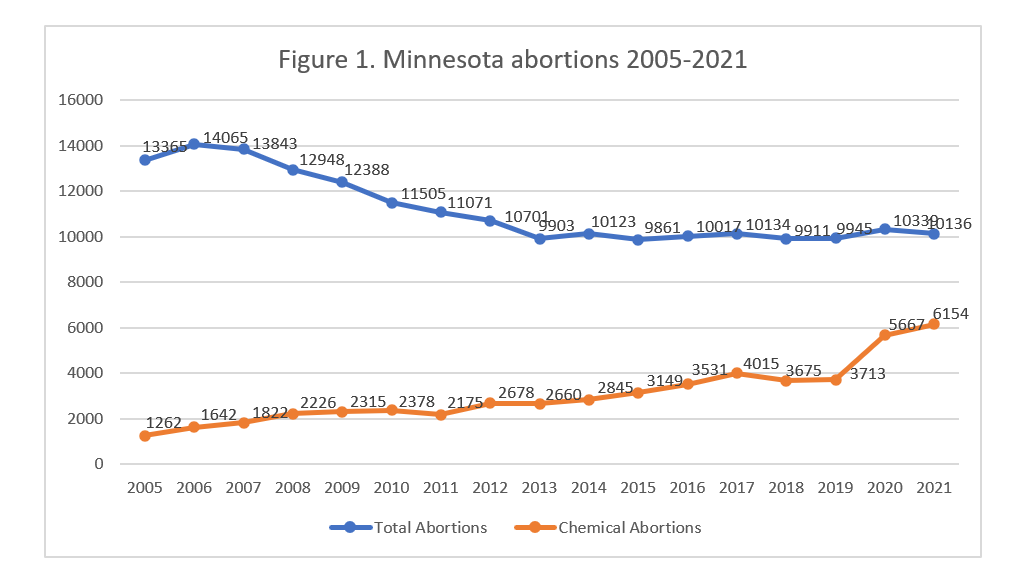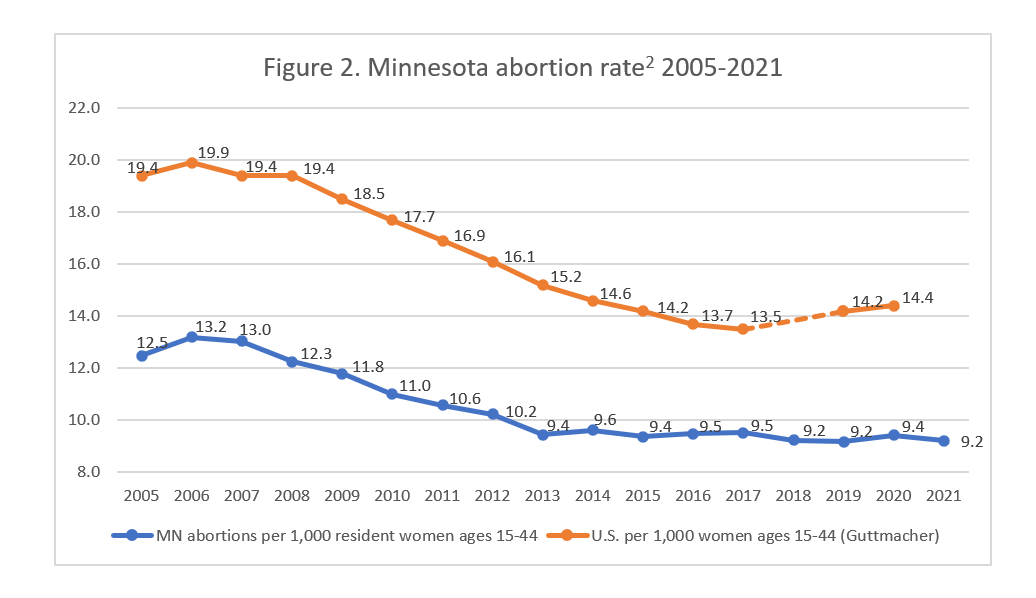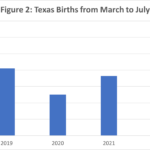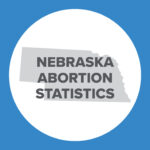Abortion Reporting: Minnesota (2021)
Minnesota’s annual abortion report for 2021 was published online by the Minnesota Department of Health in July 2022. The report shows that Minnesota’s abortion total decreased from 2020.
Statistics and Changes in Minnesota Abortions, 2020-2021

Abortion Totals and Trends
In 2021, there were 10,136 abortions reported in Minnesota, a decrease of two percent from 2020 when there were 10,339 abortions (Fig. 1). Chemical abortions made up 61 percent of the total, increasing by nine percent from 5,667 in 2020 to 6,154 in 2021. The Charlotte Lozier Institute (CLI) estimates that Minnesota’s abortion rate decreased by two percent from 2020 to 9.2 abortions per 1,000 women ages 15 to 44 (Fig. 2). As of November 2022, 24 states had released 2021 abortion statistics, with 6 states indicating that abortions had decreased from the prior year.
State Report Summary
Ninety percent of the abortions reported in Minnesota in 2021 were carried out on Minnesota residents, while 10 percent were performed on women from other states, including six percent on women from Wisconsin and almost two percent on women from South Dakota.
A majority of Minnesota abortions were performed on women in their twenties, with 27 percent on women ages 20 to 24 and 28 percent on women ages 25 to 29. Thirty-two percent were obtained by women in their thirties. Nine percent were performed on girls under the age of 20, including two percent on girls under age 18, and four percent were performed on women over the age of 40.
Forty-five percent of the abortions reported in 2021 were performed on white women. Twenty-seven percent were on black women, and seven percent were on Asian women. Three percent were obtained by American Indian women, and 11 percent were on women of other races. Race was not reported for six percent of the abortions. CLI estimates that Minnesota’s black abortion rate was 28.8 abortions per 1,000 women ages 15-44, over five times the white rate of 5.3. Eighty-two percent of the abortions were on non-Hispanic women and 10 percent on Hispanic women, while ethnicity was not reported for eight percent.
Unmarried women accounted for a large majority of the abortions reported in Minnesota (81 percent), compared to 15 percent on married women and four percent on women of unknown marital status. The majority of Minnesota abortions were performed on women who had graduated from high school: 25 percent were obtained by women with a high school diploma as their highest level of education; 25 percent were on women who had attended some college; and another 25 percent were on women with a college degree. Ten percent of Minnesota abortions were performed on women who had not graduated from high school, and 15 percent were on women whose level of education was not reported.
Sixty percent of Minnesota abortions were obtained by women who had previously had a live birth, with 23 percent on women with one prior live birth and 37 percent on women with two or more live births. Forty-one percent of the abortions reported in 2021 were performed on women who had previously had an abortion. Twenty-three percent were obtained by women with one previous abortion, and 17 percent were performed on women with more than one prior abortion. Forty percent of Minnesota abortions were performed on women with no prior live births, and 59 percent were performed on women with no previous abortions. Twenty percent were obtained by women who had previously suffered a miscarriage.
A majority of the abortions reported in Minnesota, 61 percent, were chemical abortions. Most of the chemical abortions were induced using mifepristone (58 percent of all abortions reported in Minnesota), while three percent of Minnesota abortions were induced using misoprostol as the principal drug. There were three “other” chemical abortions, a category that includes late-term induction abortions.3 A third of the abortions were performed via suction curettage, and six percent were dilation and evacuation procedures. There was one abortion performed using some other type of surgical procedure and one intrauterine instillation abortion. One abortion was performed using an unreported method.
Over two-thirds of the abortions (69 percent) took place earlier than nine weeks of gestation. Fourteen percent were performed between nine and 10 weeks, and five percent occurred between 11 and 12 weeks. Six percent were performed between 13 and 15 weeks, and four percent between 16 and 20 weeks of gestation. There were 160 abortions (1.7 percent) at 21 weeks of gestation or later. Of these, 112 were performed between 21 and 22 weeks, 47 between 23 and 24 weeks, and one at 25 weeks of gestation.
In 2021, there were 118 intraoperative complications, or complications identified at the time of the abortion procedure and reported on the abortion reporting form. Multiple complications could be reported for a single abortion. There were seven cervical lacerations, 12 cases of heavy bleeding or hemorrhage, and 99 unspecified complications.
Additionally, there were 81 postoperative complication reports submitted with information on 87 complications. The complication reports do not indicate where the abortion was performed or the residence of the woman, so Minnesota’s report cautions that this data cannot be used to produce a complication rate. There were 43 failed abortions in which the pregnancy was ongoing and 27 incomplete abortions in which pieces of the unborn baby or other pregnancy tissue were left in the woman’s uterus. There were four instances of heavy bleeding or hemorrhage, and two cases of heavy bleeding or anemia requiring transfusion. There were two cervical lacerations and one infection for which the patient had to be hospitalized. In addition, there were eight other unspecified complications.
Minnesota is one of 16 states to use its own tax dollars to fund abortion, and 46 percent of Minnesota abortions were funded through public assistance in 2021. Twenty-two percent were covered by private insurance, and 32 percent were self-pay.
Minnesota requires abortion providers to report the methods used to dispose of the bodies of unborn babies killed by abortion. In 2021, 22 percent were cremated, and 0.5 percent (46 abortions) were buried. Seventy-seven percent had not reached the stage of development to be legally required to be reported as fetal remains.
The majority of the abortions (70 percent) were performed in Planned Parenthood’s three Minnesota centers. Ten percent were reported by Whole Woman’s Health, seven percent by Robbinsdale Clinic, and five percent by Women’s Health Center. An additional seven percent of the abortions were reported by hospitals, doctor’s offices, and small clinics. Overall, 93 percent of Minnesota abortions occurred in clinics and not quite two percent in hospitals (1.3 percent as outpatient procedures and 0.3 percent on an inpatient basis). Eight abortions were performed in ambulatory surgery centers. The type of facility was not reported for six percent.
Seventy-seven doctors performed abortions in Minnesota in 2021, but over half of the doctors (40 doctors) performed fewer than 10 abortions, including 20 doctors who reported just one abortion each. Twenty-four doctors performed over 100 abortions, including six doctors who performed between 500 and 999 abortions. One doctor singlehandedly performed 1,322 abortions. Fifty-nine percent of the abortions were performed by physicians specializing in obstetrics and gynecology. Thirty-eight percent were performed by family practice or general practitioners, and two percent were performed by emergency medicine physicians.
Informed consent
The Minnesota Department of Health received 9,884 abortion informed consent forms in 2021. Of these, 9,880 showed that the women had received the required information on medical procedures and risks. One woman did not receive the information because an “immediate abortion [was] necessary to avert death” while one woman did not receive the information because a “delay would create serious risk of substantial impairment.” Two women did not receive information because their unborn babies had anomalies and they chose perinatal hospice. There were 9,871 women who were given information on available resources. Seventeen women were not required to be provided with the information since they were seeking abortions because their babies had anomalies.
Minnesota is one of just a few states to collect women’s reasons for choosing abortion. More than one reason can be selected for a single abortion. In 2021, the vast majority of Minnesota abortions were elective. There were 44 abortions (0.4 percent) for rape and 11 (0.1 percent) for incest. Twenty-eight abortions (0.3 percent) were performed due to a risk to a major bodily function, and 183 abortions (not quite two percent) were performed because the unborn baby had an anomaly.
Five babies were reported to be born alive during abortions in Minnesota in 2021. None of the babies survived after being born alive. According to the report, one baby passed away due to fetal anomalies, while in two cases “comfort care measures were provided as planned.” Two babies were judged to be previable, and no attempts were made to save their lives.
An Important Note
In 2021, the Minnesota Department of Health released a report showing that 9,108 abortions had been performed in Minnesota in 2020, a decrease from the previous year. However, pro-life groups noted that the total did not include abortions performed by Whole Woman’s Health. Minnesota’s report indicated that Whole Woman’s Health had performed 137 abortions in 2020, but the abortion center itself stated that it had performed over a thousand. Because the data for 2020 is incomplete, Charlotte Lozier Institute did not report on the 2020 data. Minnesota corrected its 2020 data in an addendum to the 2021 report which shows that Whole Woman’s Health performed over a thousand abortions.
State Ranking
In CLI’s 2016 analysis of abortion reporting across the nation, Minnesota’s reporting was ranked second best. Only Oklahoma had better abortion reporting. As CLI has recommended before, Minnesota could report the number of complications caused by each type of abortion procedure. Minnesota could also strengthen its protocols for ensuring that all abortions performed in the state are reflected in its data.

- Statistics on abortion complications reported here represent a minimal number of deaths and complications, as this data is collected in a non-systematic and non-verifiable way. As such, this data cannot be used to calculate either an accurate abortion mortality rate or an accurate abortion complication rate for the state.
- Rates were calculated by CLI using the following formula: (total number of abortions performed in Minnesota ÷ number of resident women ages 15-44) x 1,000. Rates may differ slightly from previous CLI articles due to revised population estimates. Population estimates were obtained from CDC WONDER. Estimates for 2005-2009 are intercensal estimates of the July 1 resident population. Estimates for 2010-2019 are Vintage 2020 postcensal estimates of the July 1 resident population. Estimates for 2020-2021 are Vintage 2021 postcensal estimates of the July 1 resident population. Estimates were produced by the U.S. Census Bureau and the National Center for Health Statistics.
- Minnesota updated its abortion procedure categories in 2017. To allow for comparison with earlier reports, “other” chemical abortions, which include labor induction abortions, are excluded from the chemical abortion total. There were three “other” chemical abortions in 2021.
Click here to view reporting from:2023202220202019201820172016
























